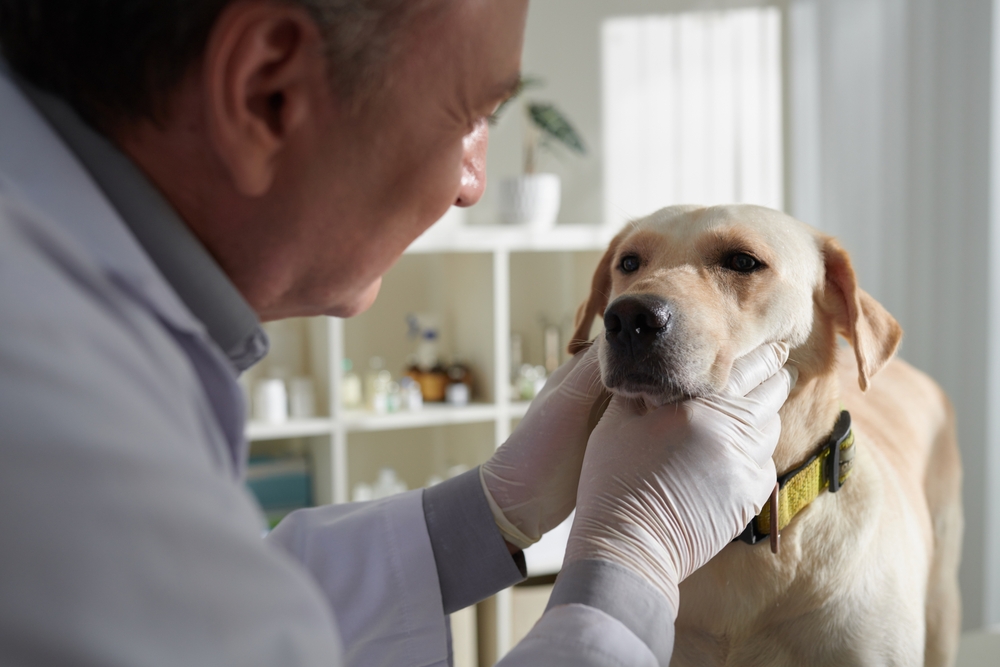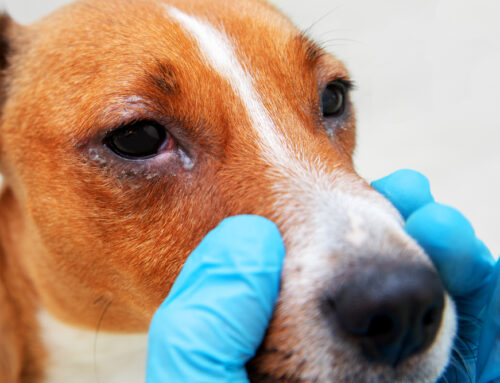Labrador retrievers are friendly and loyal, but like many purebred dogs, they can develop genetic or inherited conditions. Genetic eye conditions in Labs can adversely affect vision or cause chronic discomfort. Lab owners should learn to recognize common eye disease signs and understand how to handle a suspected eye disorder. The Veterinary Vision Center team shares details about common genetic eye conditions in Labs.
1. Cataracts in Labradors
Cataracts are characterized by cloudiness in the eye’s normally clear lens, which sits behind the iris and pupil and focuses light on the retina. Cataracts physically obstruct vision, leading to partial or complete blindness in many affected dogs. This genetic eye condition can develop because of age, or problems with glucose metabolism in diabetics. Signs include a cloudy or bluish appearance inside the eye and impaired vision, especially in low light or bright sunlight. Surgery can restore vision in dogs with advanced cataracts.
2. Corneal dystrophy in Labradors
Corneal dystrophy causes spotty or diffuse clouding in the cornea, the “window” that covers the front of the eye. In Labradors, this can occur in the outer or middle corneal layers. The genetic eye condition can impair vision if the cloudiness is extensive. If the dystrophy affects the outer corneal layer, small ulcers can develop and may require antibiotic treatment or a procedure to resolve. However, most dogs do not need corneal dystrophy treatment.
3. Distichiasis in Labradors
Labs with distichiasis grow extra eyelashes, usually when they are young, that rub on the eye’s surface, potentially causing irritation or ulcers. Symptoms include excessive tearing, squinting, or redness. Surgery to remove the extra eyelashes is recommended for pets suffering from chronic irritation, which could lead to scarring and vision loss if left untreated.
4. Entropion in Labradors
Entropion is a genetic eye condition in which usually the lower, but sometimes the upper eyelid, rolls inward, causing the eyelashes to rub against the cornea. Like distichiasis, this rubbing can lead to discomfort, corneal ulcers, and eventual vision impairment. Signs include excessive tearing, squinting, redness, and visible rolling of the eyelid skin. Surgery is typically required to correct the eyelid position.
5. Iris cysts in Labradors
Labs can develop cysts in the eye’s iris or ciliary body. These cysts are usually benign and typically don’t cause any problems with eye comfort or health. However, if the cysts are so numerous that they interfere with vision, they can be carefully removed surgically. Regular eye examinations are recommended to monitor cysts and determine if treatment is necessary.
6. Congenital and developmental disorders in Labradors
Labrador retrievers may be born with congenital eye conditions, including persistent pupillary membranes (PPMs) and retinal dysplasia. PPMs are remnants of fetal eye tissue that persist after birth, potentially impairing vision, depending on their placement. Retinal dysplasia causes abnormal retinal development, which may or may not impair vision. Mild cases often go unnoticed until detected during a routine physical examination.
7. Progressive retinal atrophy in Labradors
Progressive retinal atrophy (PRA) causes progressive thinning and degeneration of the retina, leading to gradual blindness over months to years. Symptoms usually start with night blindness and progress to complete blindness. PRA is not treatable, but the condition is painless, and blind dogs can lead a high-quality, fulfilling life. An eye health vitamin called Ocu-Glo may help to slow vision loss, but cannot prevent it entirely.
Eye health screenings in Labs

Screening puppies and breeding dogs may help reduce the incidence of genetic diseases in Labrador retrievers. Board-certified veterinary ophthalmologists like ours can provide special screening examinations and submit the results to a national database to help track and learn more about the conditions. Additionally, blood tests are available to identify the genes that cause select conditions.
Understanding the genetic eye diseases that can affect Labrador retrievers is crucial for ensuring their health and well-being. If you notice changes in your Lab’s eyes, or want to schedule a screening exam for a puppy or adult, contact the Veterinary Vision Center team.







Leave A Comment